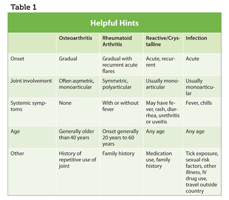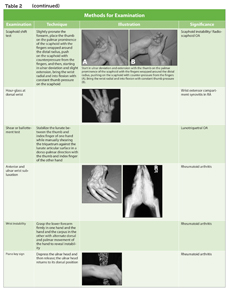Arthritis of the Elbow, Wrist and Hand
Arthritis is a broad descriptive term for inflammation and possible damage to joints due to a variety of possible etiologies. Clinically, it is characterized by joint pain, tenderness, limitation of movement, crepitus, effusion and variable degrees of inflammation.

Image: Culp RW, Jacoby SM. Musculoskeletal Examination of the Elbow, Wrist, and Hand: Making the Complex Simple; 2012.
Osteoarthritis (OA), sometimes termed degenerative arthritis, is the most common type. Other types result from infection, metabolic conditions, skeletal dysplasias, trauma and inflammatory arthritides (eg, rheumatoid arthritis [RA] and psoriatic arthritis), crystalline deposition disease, and neuropathic disorders.
The hand, wrist and elbow can be affected by all forms of arthritis to varying degrees. In the hand, the joints most frequently affected by OA are the distal interphalangeal (DIP) joints and thumb carpometacarpal (CMC) joint. The metacarpophalangeal (MCP) joints are less commonly affected by OA, but are frequently involved in RA. In the wrist, degenerative arthritis and trauma can cause carpal instability and altered kinematics, resulting in specific patterns of radiocarpal arthritis, which typically first involves the radial scaphoid joint. In advanced RA, wrist deformity can be severe, resulting in secondary loss of hand function. The distal radioulnar joint (DRUJ) is involved occasionally in OA but frequently in RA. The DRUJ deformity resulting from RA is termed the “caput ulna syndrome,” in which the ulnar head is subluxated and prominent dorsally. Primary OA of the elbow is rare and most frequently seen in middle-aged male laborers. More common causes of elbow arthritis are post-traumatic, crystalline deposition, inflammation, osteonecrosis and osteochondritis dissecans. Elbow involvement has been reported in up to 65% of patients with RA, but hand and wrist involvement is usually more disabling early in the disease.
History
Symptoms of arthritis usually develop slowly but are progressive, causing the patient intermittent pain, stiffness and weakness. Pain is exacerbated by use, particularly after prolonged activity, and is usually improved by rest. However, as the disease progresses, rest pain becomes more common. Joint pain is often difficult to localize and is frequently exacerbated by cold and damp weather. Early in the disease, patients feel stiffness, especially in the morning and after periods of inactivity, but measured loss of motion is minimal. In OA, periods of stiffness are typically less than 30 minutes, while RA patients can have prolonged periods of stiffness.

Loss of function results from a combination of pain, stiffness, deformity, contractures, muscle spasm and muscle atrophy. Understanding the severity of actual disability is paramount to properly treat patients. In some cases, radiographs indicate severe disease, but the patient claims good function with minimal impact on personal, recreational or vocational activities (Table 1).
Examination
To determine the overall impact of arthritis, a comprehensive physical examination including the hand, wrist, elbow and shoulder is necessary. A systematic approach to the examination includes inspection, palpation, assessing both active and passive range of motion, strength testing, neurovascular assessment, and tests specific to the joint of concern. Joint enlargement, redness, deformity and tenderness are hallmarks of inflammation. Isolating points of tenderness helps the examiner reproduce the patient’s symptoms and identify the source of pain.
Hand
The DIP joint is the most common joint of the hand afflicted by OA. Both pain and deformity are the primary concerns of the patient; however, the pain tends to be intermittent and often gradually improves, despite progressive deformity in some cases. Osteophyte formation involving the dorsal margin of the joint is the hallmark physical feature. The osteophytes produce visible and palpable enlargements termed Heberden’s nodes (see Table 2). In more advanced arthritis, the DIP joint can develop deformity in the form of a droop or lateral deviation. Occasionally, “mucous” cysts, which contain clear fluid, form over the joint. The cyst may cause the overlying skin to thin, resulting in spontaneous rupture. Nail plate deformity distal to the cyst is also common due to pressure on the nail bed. The cysts can be painful and patients often choose surgical excision.

Although less common, similar changes can occur in the proximal interphalangeal joints due to OA. The osteophytic enlargements are termed Bouchard’s nodes. proximal interphalangeal joint stiffness is more disabling than DIP joint stiffness, and thus patients complain of decreased dexterity in addition to the pain. Stenosing flexor tenosynovitis (trigger finger) can sometimes mimic PIP arthritis. Metacarpophalangeal joint OA is the least common site in the fingers, but there is predisposition in the index and long fingers, particularly in men. Pseudogout and hemochromatosis also affect the MCP joints, and thus a broader medical workup may be indicated. In some individuals with a strong family history, advanced OA can involve multiple joints in multiple digits, resulting in asymmetrical deformities that create a snake-like appearance of the fingers. When severe periarticular erosions and more obvious inflammation are present, the term erosive OA is sometimes used.
The first CMC joint is the second-most common location of OA in the hand but is the most frequent cause of functional disability due to the importance of the thumb. Other causes of pain in this region of the hand also must be considered, including carpal tunnel syndrome, de Quervain’s disease, stenosing flexor tenosynovitis and wrist arthritis. On physical examination, there is tenderness over the joint line which can usually be palpated directly, and often a squared appearance on the radial side of the base of the thumb (“shoulder sign”) due to joint subluxation. The “grind test” is performed by applying axial compression combined with passive circumduction (circular motion of the joint), which produces pain and crepitance (see Table 2). A secondary hyperextension and abduction deformity of the thumb MCP joint is common, as the patient attempts to make up for the loss of first CMC abduction and overall motion.
The rheumatoid hand is characterized by certain patterns of deformities that have descriptive terms, including “ulnar drift,” “swan neck” and “boutonniere” (see Table 2). These deformities are caused by a combination of articular erosions and soft tissue laxity. Ulnar drift refers to ulnar deviation of the fingers at the MCP joints, which usually develops gradually and involves all fingers of that hand. As the deformity becomes more severe, palmar-ward subluxation of the joints occurs, leading to greater loss of motion and dexterity. Swan neck refers to hyperextension at the PIP and flexion at the DIP joint, which can be a flexible or fixed deformity that reduces grip strength. Boutonniere deformity describes flexion at the PIP joint and hyperextension at the DIP joint, which also can be flexible or fixed but causes less loss of function. The thumb can develop similar changes, but a boutonniere deformity is the most common. As opposed to patients with OA, patients with RA usually have a more symmetrical distribution of joint involvement; however, the severity of deformity can substantially vary. Joints with severe erosions become flail and digits shorten. With traction, folds in the redundant skin telescope out, hence the term opera glass hand applied to a hand with severe disease.
Rheumatoid nodules are a common feature of the disease and are typically found over the extensor surfaces of the hands and arms (see Table 2). They are firm and rubbery and can become large. In addition to the three common deformities already listed, other common hand deformities in RA include palmar subluxation of the MCP joints, Z-deformity of the thumb, lateral dislocation of the IP joints and misalignment of the digits, suggestive of tendon rupture.
Wrist
Wrist OA is relatively common but frequently tolerated and responsive to routine medications, rest and modification of activities. However, some patients develop substantial swelling and pain. Joint line tenderness is particularly helpful to assess the location of the arthritis, but confirmation with radiographs is often necessary to determine its true location.

The most common pattern of wrist arthritis is called the scapholunate advanced collapse (SLAC) wrist, which begins at the articulation between the radius and scaphoid and progresses in a specific pattern to involve scaphocapitate and capitolunate articulations arthritis followed by generalized wrist arthritis. This pattern is thought to be initiated by or at least accelerated by a tear of the scapholunate interosseous ligament. A variation of the SLAC wrist is the scaphoid nonunion advanced collapse (SNAC) wrist, which implies a longstanding nonunion of the scaphoid that causes malalignment of the carpus that induces degenerative changes.
Clinical examination will reveal swelling and tenderness in the “anatomic snuff box,” which is the normal depression over the dorsal radial aspect of the wrist and anatomically lies over the scaphoid between the first and second dorsal extensor tendon compartments. This normal depression becomes reversed to become a prominence due to swelling. Unless wrist stiffness has developed, the scaphoid shift test is positive. This is begun by slightly pronating the forearm, placing the thumb on the palmar prominence of the distal scaphoid, and wrapping the fingers around the distal radius. While applying pressure on the scaphoid with the thumb and counter-pressure with the fingers, the wrist is moved from ulnar deviation and slight extension into radial deviation and slight flexion (see Table 2). In radioscaphoid arthritis, this maneuver usually results in pain; relative hypermobility of the scaphoid; and sometimes crepitance, clicking, or a “clunk.” Comparison should be made with the opposite wrist.
The second most common site of wrist OA is at the scaphotrapezial trapezoidal joint. Examination will reveal swelling and fullness slightly more distal than radioscaphoid arthritis. There also may be swelling on the volar radial aspect of the wrist. The palmar scaphoid and the distal flexor carpi radialis tendon are tender. Radial ulnar deviation of the wrist typically causes pain because the joint undergoes the greatest motion during this movement.
Excerpted from Culp RW, Jacoby SM. Musculoskeletal Examination of the Elbow, Wrist, and Hand: Making the Complex Simple (pp. 252-273). © 2012 SLACK Incorporated.
- References
- Adams BD. Distal radioulnar joint instability. In: Green DP, Hotchkiss RN, Pederson, WC, Wolfe SW, eds. Green’s Operative Hand Surgery, Fifth Edition. Philadelphia: Elsevier Churchill Livingstone; 2005:605-644.
- Berenbaum F. Osteoarthritis: Epidemiology, pathology, and pathogenesis. In: Klippel JH, ed. Primer on the Rheumatic Diseases. Atlanta: Arthritis Foundation; 2001:285-289.
- Boumpas DT, et al. Rheumatoid arthritis. In: Klippel JH, ed. Primer on the Rheumatic Diseases. Atlanta: Arthritis Foundation; 2001:209-232.
- Chaisson CE, et al. J Rheumatol. 1997;24:1337-1343.
- Cooney WP, et al. Physical examination of the wrist. In: Cooney WP, Linscheid RL, Dobyns JH, eds. The Wrist: Diagnosis and Operative Treatment. St. Louis: Mosby; 1998:236-261.
- Cooney WP, et al. Post-traumatic arthritis of the wrist. In: Cooney WP, Linscheid RL, Dobyns JH, eds. The Wrist: Diagnosis and Operative Treatment. St. Louis: Mosby; 1998:588-631.
- Goldring MB. Arthritis Rheum. 2000;43:1916-1926.
- Gramstad GD, et al. J Bone Joint Surg Am. 2006;88:421-430.
- Kauffman JI, et al. J Am Acad Orthop Surg. 2003;11:100-108.
- Mankin HJ, et al. Articular cartilage repair and osteoarthritis. In: Buckwalter JA, Einhorn TA, Simon SR, eds. Orthopaedic Basic Science: Biology and Biomechanics of the Musculoskeletal System, Second Edition. Rosemont, IL: American Academy of Orthopaedic Surgeons; 2000:471-488.
- Sharma L. Epidemiology of osteoarthritis. In: Moskowitz RW, Howell DS, Altman RD, Buckwalter JA, Goldberg VM, eds. Osteoarthritis, Third edition: Diagnosis and Medical/Surgical Management. Philadelphia: WB Saunders Company; 2001:3-27.
